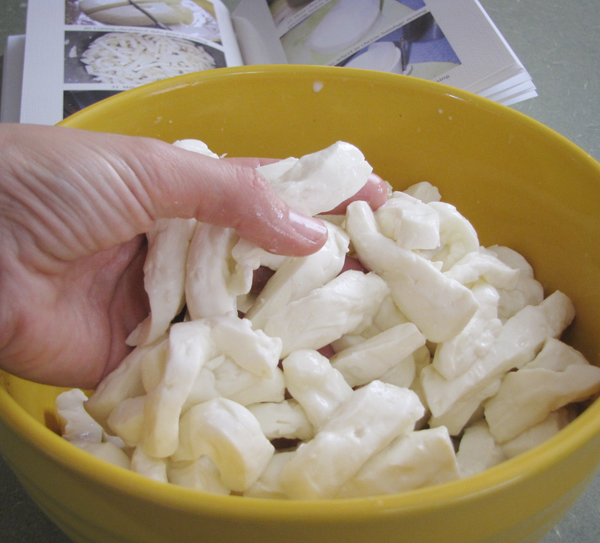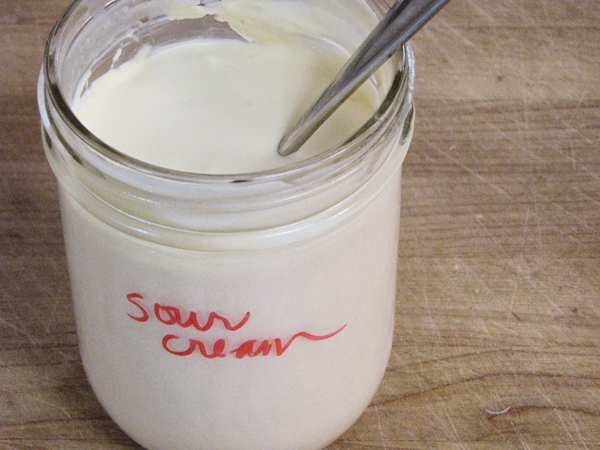Take milk or cream and allow a mother culture — beneficial organisms — to proliferate, spreading their probiotic goodness throughout the milk or cream. That is cultured dairy at its most basic level.
The many variations on the basic culturing process determine whether you end up with sour cream, butter, buttermilk, cheddar cheese, cottage cheese, or any other cultured dairy foods. The history of the world is closely tied to dairy and cultured dairy; most cultures have a traditional cultured dairy food.
“And I am come down to deliver them out of the hand of the Egyptians, and to bring them up out of that land unto a good land and a large, unto a land flowing with milk and honey.” –Exodus 3:8
By the way, don’t think that the usual dairy products in the grocery store are healthful cultured dairy. They may taste good (thanks to fake flavorings), but in their tasty, colorful packages, you’re likely to find additives, colorants, thickeners, and/or sugar. Not a beneficial organism to be found (exception: yogurt with active cultures).
Why Eat Cultured Dairy and Cheese?
Beyond the culturing process being simply amazing and awe-inspiring, thanks to the Lord’s design, why eat cultured dairy? At the risk of sounding like a broken record, I’d like to again quote Dr. Tom Cowan, who explains that beneficial organisms (aka probiotics or cultures) are essential for a healthy gut, and a healthy gut is essential for a strong immune and digestive system. You can’t truly be healthy without feeding your gut. Cultured dairy foods do that.
“Think of your intestines as soil and grass: the villi are like the soil, and the layer of good bacteria is like the grass covering the soil. If you go to a meadow or a perennial grass field and you overgraze or do something to strip the grass, the soil will become eroded. If this condition continues, you get further erosion of soil, you get cracks in the soil, and surface material starts seeping into the ground water. That is exactly the same process that happens in the human gut. People “strip their grass” with antibiotics, with vaccines, with processed foods, with not getting the right flora via the birth canal due either to a C-section or gut dysbiosis in the mother. Lastly, “civilized” people today are no longer eating probiotic foods. All these factors create an unhealthy gut ecology, a flattening of the villi, and actual holes in the gut wall.” –Wise Traditions article by Tom Cowan, MD
Be Un-Civilized!
As Dr. Cowan pointed out that “civilized” people today do not eat probiotic foods, I challenge you to be less civilized. And I’m more than happy to facilitate your undoing in my Cultured Dairy and Basic Cheese eCourse. 🙂 We cover so much — sour cream, buttermilk, butter, kefir, yogurt, soft cheese, cottage cheese, cheddar cheese, Middle Eastern fresh cheese, feta cheese, queso fresco cheese, mozarella cheese, and more!
In the coming days on the blog, I’ll be diving into cultured dairy, which will be helpful whether or not you’re taking the class. I’ll also help you get ready if you are taking the class.
Coming later this week: the top 6 reasons to eat cultured dairy. One reason is in this post (probiotics), and the rest are new. One of them might surprise you. Well… maybe, maybe not.
So, who wants to join me and my family in being less civilized? 🙂
...without giving up the foods you love or spending all day in the kitchen!

2 free books:
Eat God's Way
Ditch the Standard American Diet, get healthier & happier, and save money on groceries...
We only recommend products and services we wholeheartedly endorse. This post may contain special links through which we earn a small commission if you make a purchase (though your price is the same).




Haha, I’m all for being less civilized!! Ain’t it great!? 🙂 SO looking forward to this class!
I think it is great, too! I am beyond excited as well. Thanks, Jill!
I’m in! I’ve been wanting to eat more cultured foods and this will be the incentive to just DO IT! When I took your fundamentals class, Wardee, I loved how it helped me get over the hump and do things differently on a regular basis rather than being so hit and miss. I’m sprouting lots more seeds now and I never boil a chicken without doing the GNOWFGLINS way. And my youngest is a huge fan of soaked rice!!
Amy, that’s awesome how you’ve implemented those changes and your family has embraced them. I’m happy you’re joining us!
Ha ha, I’ll be less civilized if Wardee is!
😀 At least we’re in it together! I sit here in my barn clothes — I’m actually quite un-civilized!
You are so humble Wardee. It makes your teaching syle just that more enjoyable. I’d be honored to have tea with you in your barn clothes!
Sooooo excited!!!
I think your class sounds so wonderful, Wardee! Hooray for you!
I would also like to add that the regular sour cream I buy at the store is just cultured soured cream – no additives, other ingredients, etc. We love it! It isn’t homemade, but it’s nice that there is at least something like that available. It’s not even in the health food section. It’s made in the Pacific Northwest, so it is fairly local to me.
Oh, what brand is that? 🙂 I’d like to check it out as a possible good conventional source. Thank you!
I use Daisy and all it is is cultured cream. I doubt it is grass fed, but its better than the ones with all of the additives.
I am thinking about the course, but I have a quick question. I do not have raw milk available to me. I would have to use what I can get at the grocery. Is that useable or not? I use it right now to make kefir, sour cream, buttermilk, and yogurt, but we have wanted for years to learn to make cheddar cheese.
Kelli — You’ll be able to use store-bought milk, as long as it is not ultra-pasteurized. Sounds like that’s what you’re doing already. 🙂
I’m still working my way through the Fundamentals, but I’m sure looking forward to learning more about cultured dairy. I’ve not done anything beyond kefir, yogurt and the soft cheese made by draining those! I do have Rikki Carroll’s Home Cheese Making book, but so far I’ve not used it much. Which is funny since it’s been sitting out on my kitchen counter in my Frequently Used Cookbooks space for over a year…I even ordered the liquid rennet and a couple of other things at the same time! This is why I need your upcoming e-course. I can’t tell you all the things I’ve started doing again since signing up just last week. Soaking nuts, grains, salad sprouts, and flours, fermenting vegetables-having everything in a binder and a forum available to read questions/answers sure does make a difference. It all feels more manageable to me. Before, I was afraid of forgetting something and didn’t want to have too many cultures going at once.
Thanks for making this new way of preparing food so much easier. Breaking it down really does work.
I buy Daisy sour cream. The only ingredient is “cultured cream”. Some of the cheaper brands have an ingredient list a mile long!
I make creme fresh sometimes, but it doesn’t have the “zip” in some recipes that real sour cream has.
Count me in! We are big dairy people around here. My son has two dairy goats have are in milk right now and this spring I believe that he has six that are going to kid! We are going to be up to our eyeballs in milk soon. I can’t wait!
We are also going to get a dairy cow this year. Big decision!
Bring on the info!
Blessings to you, Wardee!
Wardee, I’d love to try these recipes with sheep’s milk. Can I?
Carmen — I would say yes, because sheep’s milk provides the basis for cultured dairy foods in many parts of the world. I have had sheep’s feta before and it was out of this world. 🙂 We may have to do some research to see if there are any adjustments. I’d love to hear more about your family’s source of sheep’s milk and how you use it and how you like it!
Hi there, I just stumbled upon your site & it is very informative! I am very interested in making cultured coconut milk & yogurts. I am trying to incorporate more organic coconut into my diet for the beneficial medium chain fats. (I ordered a yogurt maker, which just arrived today by YoLife)
Don’t get me wrong, I adore dairy, but am trying to broaden my horizons! (by the way I do love goat cheese & fresh mozzarella & found raw chedder at my local store).
In addition, trying to remove gluten out of my diet & eat less processed foods.
Looking forward to getting familiar with your site. 🙂
~Cindy
Haha, I’m all for being less civilized!! This is why I need your upcoming e-course. I sit here in my barn clothes — I’m actually quite un-civilized! Don’t get me wrong, I adore dairy, but am trying to broaden my horizons!
HI,
When the milk is cultured, is the why removed/neutralized? I ask because I have a food sensitivity to whey.
Stephanie — It depends on what your end result is. If you make a cheese (like cheddar, feta, yogurt cheese, etc.), the whey is dripped out during pressing or hanging. If you’re making yogurt or kefir, it is all mixed up in there with the curds unless you hang it and let the whey drip out.